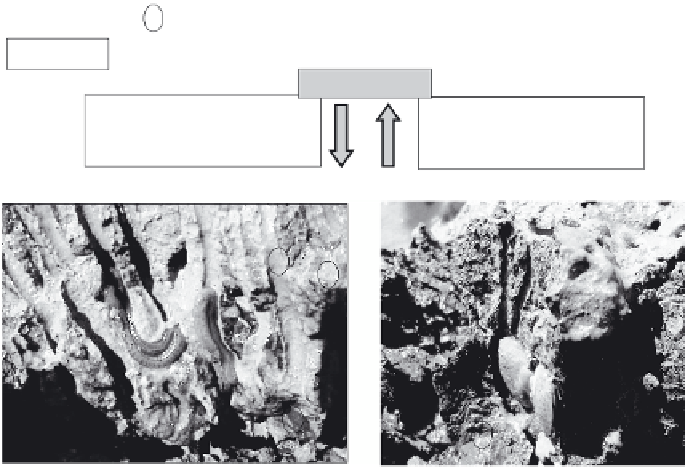Biology Reference
In-Depth Information
1
Anoxic sediment
Oxygenated
sediment
2
Predators
Predators
Water stream
Fluxes of organic and/or
mineral matter, dissolved or
particulate
Fluxes of organic and/or
mineral matter, dissolved or
particulate
Oxygenation
2
1
2
N
1
N
S
S
1
1
(a)
(b)
FIGURE 7.3
(a)
Nereis diversicolor
and (b)
Scrobicularia plana
: keystone species of the sedimentary estuarine compartment
through their biomass and their activities of bioturbation.
These authors, studying the ecological consequences of the effects of contaminants on the
behavior of the mummichog
Fundulus heteroclitus
(a fish) and its main prey, the grass shrimp
Palaemonetes pugio
, showed that the capacity of mummichog for predation was decreased
by contaminant exposure, such that they then consume more detritus that are of low food
value. This lower quality nutrition supply, associated with hormonal and/or neurological
disturbances, in turn, makes the mummichog more vulnerable to predation by other fish
or by the blue crab
Callinectes sapidus
. The changes in the behavior of
F. heteroclitus
, a key-
stone species of the estuarine ecosystem, and modifications of the structure of its popula-
tions, thus generate in turn changes in the whole ecosystem, in particular by leading to an
increase in the population density and the size of the local grass shrimp, but also a modifica-
tion of the quantity of available prey for higher levels in local food chains (Weis et al. 2001).
However, the effects on community structure go beyond only the trophic relations between
some species: Kneib and Stiven (1982), studying the effects of various classes of size of killifish,
F. heteroclitus
, on the abundance of diverse benthic invertebrates, showed that the density of the
benthos was bigger in cages containing large adult individual fish. Kneib (1988) highlighted
that, by controlling populations of the grass shrimp
P. pug i of
, the large killifish had an indirect
positive effect on the dwarf mud anemone
Nematosella vectensis
.
Recently, Weis et al. (2011) completed their behavioral and ecological observations on the
effects of pollutant exposure on other common species living in the same ecosystem (com-
mon killifish; grass shrimp; blue crabs; fiddler crabs,
Uca pugnax
; and bluefish,
Pomatomus
saltatrix
). They showed for each species of the ecosystem, alterations of feeding and tro-
phic interactions, but with different consequences for each. They pose questions for future
studies: (1) Are organisms at higher trophic levels more likely to be affected by pollutants?
(2) Are certain taxonomic groups more likely to be successful under contaminant stress?
(3) Are certain traits associated with being more successful in contaminated areas? (4) Are

























Search WWH ::

Custom Search